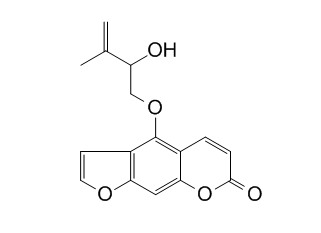Gosferol
Inquire / Order:
manager@chemfaces.com
Technical Inquiries:
service@chemfaces.com
Tel:
+86-27-84237783
Fax:
+86-27-84254680
Address:
1 Building, No. 83, CheCheng Rd., Wuhan Economic and Technological Development Zone, Wuhan, Hubei 430056, PRC
Providing storage is as stated on the product vial and the vial is kept tightly sealed, the product can be stored for up to
24 months(2-8C).
Wherever possible, you should prepare and use solutions on the same day. However, if you need to make up stock solutions in advance, we recommend that you store the solution as aliquots in tightly sealed vials at -20C. Generally, these will be useable for up to two weeks. Before use, and prior to opening the vial we recommend that you allow your product to equilibrate to room temperature for at least 1 hour.
Need more advice on solubility, usage and handling? Please email to: service@chemfaces.com
The packaging of the product may have turned upside down during transportation, resulting in the natural compounds adhering to the neck or cap of the vial. take the vial out of its packaging and gently shake to let the compounds fall to the bottom of the vial. for liquid products, centrifuge at 200-500 RPM to gather the liquid at the bottom of the vial. try to avoid loss or contamination during handling.
J Cell Biochem.2024, 125(4):e30537.
Front Pharmacol.2021, 12:744624.
Front. Pharmacol.2022, 901563.
Nutrients.2024, 16(7):985.
J of Health Science and Alternative Medicine2019, 1(1)
J of Engineering Science&Technology2018, 13(9):2820-2828
Molecules.2021, 26(4):817.
Molecules.2019, 24(10):E1926
J Appl Biol Chem.2022, 65(4):pp.463-469.
Indian J Pharm Sci.2022, 84(4): 874-882.
Related and Featured Products
Pharm Biol . 2014 Dec;52(12):1543-1549.
Antiviral and cytotoxic evaluation of coumarins from Prangos ferulacea[Pubmed:
25026335]
Context: Prangos ferulacea (L.) Lindl. (Apiaceae) is a perennial plant found in the Middle-East, where it is commonly used as an antispasmodic and anti-inflammatory agent. It is a rich source of coumarins.
Objective: To purify several coumarins from P. ferulacea and to screen their cytotoxicity and anti-herpes activity.
Materials and methods: Acetone extract of roots of P. ferulacea was subjected to several chromatographic separations to render pure coumarins (1-8). Anti-herpes virus effects of 1-7 were evaluated at concentration 2.5, 5, and 10 μgmL(-1), on a confluent monolayer of Vero cells infected with 25 PFU of HSV1. Cytotoxic effects of 1 and 2 were evaluated on an A2780S cell line using the MTT assay. The cells were exposed to a series of concentrations of coumarins (0.01-2.5 mM, 37°C, 72 h).
Results: Compounds 1-8 were identified as osthole, isoimperatorin, oxypeucedanin, psoralen, oxypeucedanin hydrate, Gosferol, oxypeucedanin methnolate, and pranferol. This is the first report of occurrence of 4 and 7 in this plant. Compound 1 showed a viability of 9.41% ± 2.4 at 2.5 mM on A2780S cells (IC50 = 0.38 mM). The cell survival of 2 at 2.5 mM was 46.86% ± 5.5 with IC50 equal to 1.1 mM.
Discussion and conclusion: Compound 1 shows cytotoxic effects on the A2780S cell line. Compound 2 is a cyclooxygenase-2 inhibitor and the A2780S cell line does not express COX-2 which may interpret the non-toxic effect of the compound on this cell line. None of the tested compounds showed an anti-HSV effect at non-toxic concentrations.



